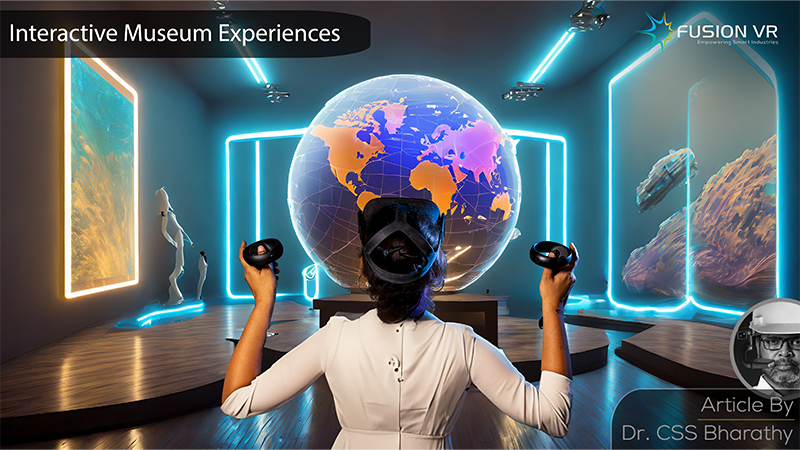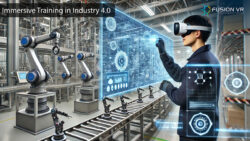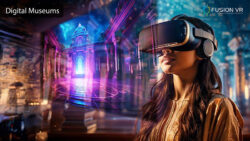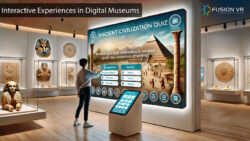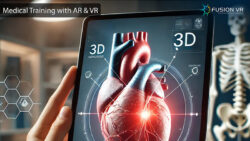Interactive museums have created a mini revolution in the way people engage with knowledge and information. It is also significantly helping to enhance the learning experience across various disciplines. Interactive museums are infusing innovations using the latest in digital technologies, hands-on exhibits, and highly creative immersive displays that are creating a high quality interactive learning environment. These exhibits and displays help to draw museum visitors to actively participate in their learning process. Museum 2.0 is the latest in museum innovation that is transforming the traditional display only museums into highly interactive and enriching centers of learning. Visitors are enjoying the immersive museum experiences and actually stepping into the story that the museum is unveiling.
Interactive museums aim to introduce visitors into immersive environments that are designed to stimulate and deliver multiple sensory experiences. The typical experience a visitor has in a traditional museum is hardly engaging. People view the exhibits and artifacts on display and there is little information to help identify or explain about the artifacts and treasures stored there. There are a few traditional museums, particularly the science museums that provide exhibits which the visitors use to understand certain scientific concepts. This is where observation is quite passive and it underscores the importance of having interactive exhibits which encourage active participation from visitors. This type of hands-on approach helps visitors learn quickly and obtain a deeper understanding and retention of concepts which makes the learning experience more enjoyable and memorable.
Personalized learning is regarded as one of the key benefits that interactive museums can provide considering the varied learning approaches and styles individuals have. We are moving away from rote learning and textbook based teaching to other effective learning methodologies and teaching approaches. Museums have the ability to help students learn at their own pace about science, history and culture. Studies have consistently indicated that these interactive approaches and exhibits lead to greater engagement and increased retention of the learning accomplished. Interactive museums provide a variety of engaging activities that are designed to include visual, auditory, kinesthetic learning preferences.
Furthermore, interactive exhibits are able to connect the theory learned in a classroom setting to an exhibit in the museum. Educators can take advantage of the interactive learning exhibits available in museums and integrate museum visits as part of their curriculum. The immersive exhibits enable the students to obtain a personalized learning experience on the topic at hand and emerge more confident and competent in the subject matter. Students and visitors at the museums are empowered to make personalized choices and engage in the interactive exhibits to gain a personalized and more effective learning experience.
Most of you would remember how exciting field trips and excursions were in your childhood. These experiential learning experiences remain rooted in our memories forever. Educators can take a cue from this and design their curriculum to include such out of the classroom learning experiences, particularly at museums. This is highly suitable for young audiences such as students from elementary and primary schools. Classroom experiences can be tedious and the young ones tend to lose focus and interest. Integrating external learning experiences with the curriculum that are interactive and gamified can be fun as well as purposeful. This approach also transforms the learning experience into one that encourages exploration and curiosity.
One of the biggest advantages of making museums interactive is the ability to provide puzzles and challenges as part of the engagement experience. This is a great way to develop in kids the ability to think on their feet, develop critical thinking and problem solving skills. This can be used to develop situational thinking skills in a historical exhibit or to test and check understanding on many scientific concepts. Repeated attempts with the interactive exhibits, help cement their understanding with this innovative learning approach. They also develop these real life skills which help them be successful in their future careers.
Since most institutional visits are by school groups, the learning experience is more enjoyable as it presents the opportunity to participate as a group or team. The social interaction and bonding that develops between students in such scenarios is a powerful motivator for enhanced learning. Kids tend to help each other in these interactive tasks, exchange ideas, learn from others by observation and gain multiple perspectives. This experience fosters collaboration and teamwork which are now considered essential soft skills in the corporate world.
The interactive museums develop the exhibits using some of the most advanced technologies. The innovation and creativity exercised in the development of these exhibits is by the expert use of technologies such as augmented reality (AR), virtual reality (VR) etc. The technical and aesthetic aspects of these interactive exhibits are exposed to the students when they use them. It’s not uncommon to see young students developing the curiosity to understand how the exhibits work and getting inspired to undertake careers in the field of AR and VR. The demand for AR/VR engineers is really high as these technologies are finding several applications across many sectors of the economy.
The museum is no longer being seen as a place to visit once in a lifetime or as part of many tourist attractions in a city. It is now a vibrant learning environment for visitors of all ages who also wish to enjoy a VR museum experience. The interactive museums no longer need to be enjoyed only when you visit them. The virtual museums which provide virtual walkthroughs using VR inside a digitally reconstructed museum replica is being established at several museums across the world. This is allowing people who are in different parts of the world, unable to visit these museums due to physical, monetary and other constraints, to enjoy the virtual museum. The VR walkthrough experience replicates an actual visit with almost the same levels of visitor satisfaction.
Learning is often a very personal experience for many. Individuals design their learning approaches that enable them to be successful. Fusion VR has a dedicated team of VR AR designers and creative staff who collaborate closely to develop exciting immersive experiences. Our projects at the Amma Museum & Knowledge Park in Chennai and the Ramakrishna Math Museums are a testament to our capabilities in the Museum 2.0 space. These museums are visited by thousands of people who learn about the life and times of a former chief minister as well as important events from the life of one the greatest spiritual leaders. The exhibits are very engaging and tell us the story. These are highly successful museum projects that has created immense confidence in us and led us to execute more challenging projects for such museums and corporate experience centers in India. The Fusion VR Museum and Corporate Experience Centers page is a good place to start to learn more about how we support the learning experience in Interactive museums.
The future of learning has to be innovative and driven by new technologies. The museums are great partners in providing this kind of learning experience. The more engaging and hands-on exhibits, the greater the learning experience for the students. The new exhibits are very informative as well as entertaining. The future of interactive museums is bound to pay rich dividends for educational institutions and their students. By appealing to the various learning styles we have it is also fostering critical thinking with the use of innovative technologies. IN doing so these institutions are playing a fantastic role in making education more interesting, accessible, enjoyable, and impactful for people of all ages. Today, more and more traditional museums are rapidly transforming themselves into highly interactive museums with AR and VR experience centers.

